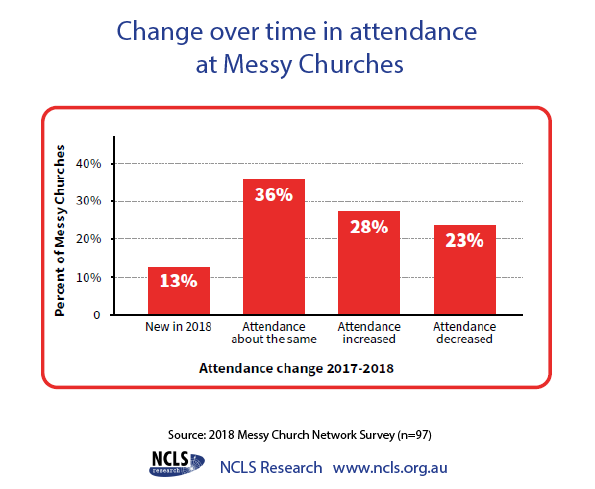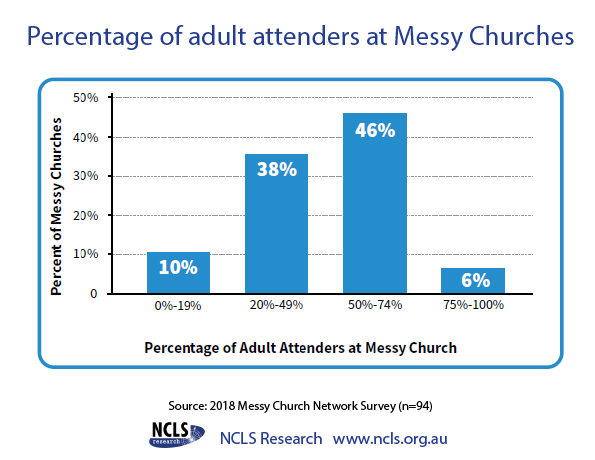Churches seeking a Messy environment by using the Messy Church format are aiming for a generational mix.
Too many adults and the Messy Church becomes a service that tends to focus on adult needs. Likewise, a ratio skewed towards children, effectively might feel more like a crèche or service for kids. Results show that most Messy Church meetings reported typical attendance of under 50 attenders.
So what has changed in the attendance patterns and what kind of intergenerational mix do Messy Churches currently attract?
Attendance levels
Of the 89 churches surveyed in the Messy Church Network in 2018, about two-thirds (65%) of Messy Church meetings typically had less than 50 people in attendance.
The most common sized Messy Church was between between 20 and 49 people (reported by 49% of churches). Less common were Messy Churches with a size of 80 people or more (only 8% of church respondents in the 2018 Messy Church Network Survey).

Change in attendance
The Messy Church Network survey found just over a third of churches (36%) with a Messy type of service were hosting about the same number of attenders as they had the previous year.
Meanwhile, just over a quarter (28%) said they were increasing in size and just under a quarter (23%) reported their numbers were decreasing from the previous year.

Intergenerational mix
In the 2018 survey there was found to be a wide range of intergenerational mixes in Australian Messy Church groups. This ranged from 75% or more adults present at some Messy Churches, to less than 20% adults in others.
Just over half of churches (52%) had more adults present at their Messy Church gathering than children and just under half of churches (48%) had more children than adults.
Messy Churches that had between half and three quarters of their attenders as adults, were most common (46% of churches).

Ministry implications
Messy Church is usually characterised by activities, a celebration, and a meal. Local churches can be pleased that there appears to be a strong intergenerational mix at Messy Church gatherings. It suggests this hands-on, family, communal meeting is hitting the right buttons; reaching the mix of ages and people at which it is targeted.
Most Messy Churches seem to include a good balance of adults and children. However, for those Messy Churches operating with fewer than 20% adults present, there may come a point where local proponents might ask themselves ‘should we adjust our format to suit all ages in a more effective way, such as including more multi-generational family attenders, or are we satisfied that this is a children’s or young person’s activity?’. Some may see the Messy Church format as entirely suitable for children or young people only, though generally a Messy Church goal is to be accessible to all ages. Alternately, for the few Messy Churches where adults are mostly represented along with only a few children, questions around including more of the younger generations may need to be addressed.
The moderate sized groups being reported by Messy Churches suggest that relationships would be able to be fostered well amongst the numbers present. Potentially in larger groups, the elements of hospitality and belonging would need special attention to remain strong.
Kathy Jacka and Sam Sterland, NCLS Research with Rod Bennett, WildHive Studios.






